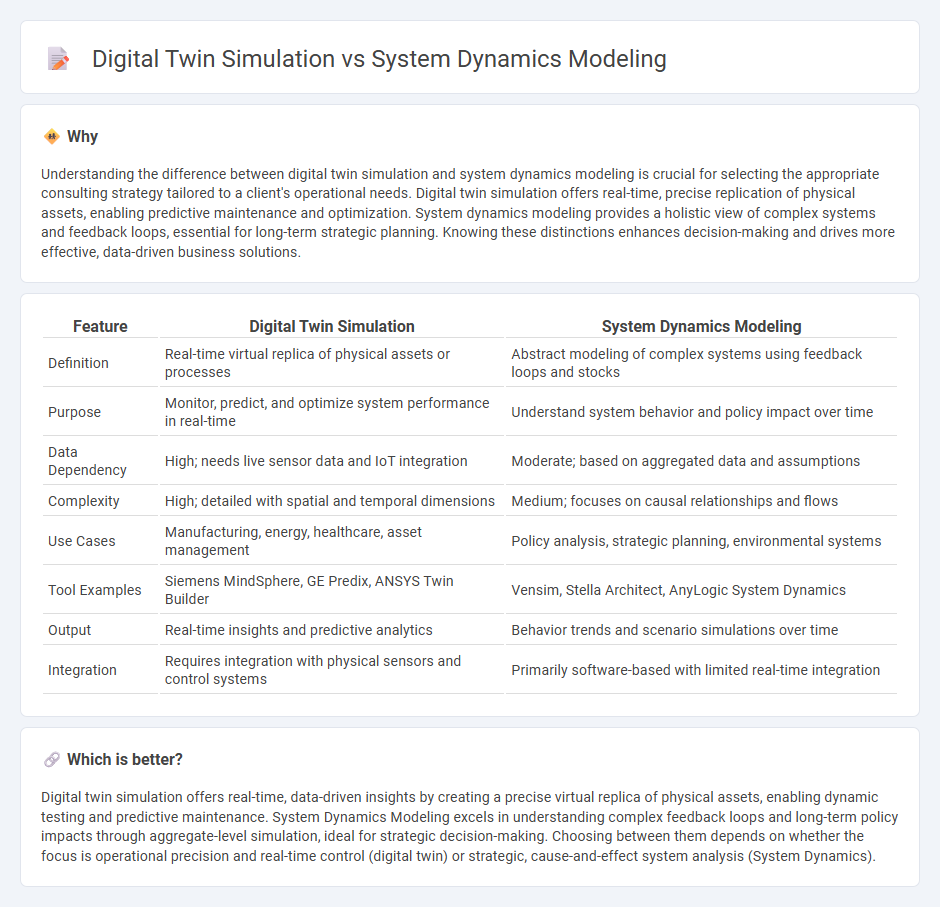
Digital twin simulation creates a real-time virtual replica of physical systems, enabling precise monitoring and predictive analysis through continuous data integration. System Dynamics Modeling focuses on understanding complex feedback loops and long-term behavior within systems to simulate policy impacts and decision-making scenarios. Explore how these advanced methodologies transform strategic planning and operational efficiency in consulting.
Why it is important
Understanding the difference between digital twin simulation and system dynamics modeling is crucial for selecting the appropriate consulting strategy tailored to a client's operational needs. Digital twin simulation offers real-time, precise replication of physical assets, enabling predictive maintenance and optimization. System dynamics modeling provides a holistic view of complex systems and feedback loops, essential for long-term strategic planning. Knowing these distinctions enhances decision-making and drives more effective, data-driven business solutions.
Comparison Table
| Feature | Digital Twin Simulation | System Dynamics Modeling |
|---|---|---|
| Definition | Real-time virtual replica of physical assets or processes | Abstract modeling of complex systems using feedback loops and stocks |
| Purpose | Monitor, predict, and optimize system performance in real-time | Understand system behavior and policy impact over time |
| Data Dependency | High; needs live sensor data and IoT integration | Moderate; based on aggregated data and assumptions |
| Complexity | High; detailed with spatial and temporal dimensions | Medium; focuses on causal relationships and flows |
| Use Cases | Manufacturing, energy, healthcare, asset management | Policy analysis, strategic planning, environmental systems |
| Tool Examples | Siemens MindSphere, GE Predix, ANSYS Twin Builder | Vensim, Stella Architect, AnyLogic System Dynamics |
| Output | Real-time insights and predictive analytics | Behavior trends and scenario simulations over time |
| Integration | Requires integration with physical sensors and control systems | Primarily software-based with limited real-time integration |
Which is better?
Digital twin simulation offers real-time, data-driven insights by creating a precise virtual replica of physical assets, enabling dynamic testing and predictive maintenance. System Dynamics Modeling excels in understanding complex feedback loops and long-term policy impacts through aggregate-level simulation, ideal for strategic decision-making. Choosing between them depends on whether the focus is operational precision and real-time control (digital twin) or strategic, cause-and-effect system analysis (System Dynamics).
Connection
Digital twin simulation integrates real-time data to create virtual replicas of physical systems, enabling dynamic analysis and optimization. System Dynamics Modeling offers a framework to understand complex feedback loops and time delays within these systems, enhancing predictive accuracy. Together, they provide consulting services with powerful tools for scenario testing, decision support, and strategic planning.
Key Terms
Feedback Loops
System dynamics modeling emphasizes feedback loops by representing complex, nonlinear interactions within systems through stocks, flows, and delays, enabling the analysis of system behavior over time. Digital twin simulation incorporates real-time data integration and high-fidelity virtual replicas of physical assets, allowing dynamic adjustments of feedback mechanisms based on live inputs for predictive maintenance and operational optimization. Explore our detailed comparison to understand how feedback loops drive system performance in both approaches.
Real-time Data Integration
System Dynamics Modeling offers a macro-level perspective on complex systems by using feedback loops and time delays to simulate behavior over time, but it generally lacks real-time data integration. Digital twin simulation incorporates real-time sensor data to create an accurate, continuously updated virtual replica of physical assets or processes, enabling dynamic decision-making and predictive maintenance. Explore how combining these approaches enhances operational efficiency and system insights through real-time data integration.
Scenario Analysis
System dynamics modeling captures complex feedback loops and time delays to analyze system behavior over time, while digital twin simulation integrates real-time data for precise, dynamic scenario analysis and operational optimization. Combining these approaches enhances predictive accuracy and decision-making by simulating various what-if scenarios with detailed system representations. Explore how leveraging both can transform your scenario analysis strategies.
Source and External Links
What is the System Dynamics Model? - System Dynamics Modeling is a methodology focused on understanding complex systems through feedback loops, time delays, and accumulations, using tools like causal loop diagrams, stock and flow diagrams, and simulation models to analyze system behavior and predict changes over time.
System dynamics - System Dynamics is an approach to understand the nonlinear behavior of complex systems over time by modeling stocks, flows, feedback loops, and time delays, originally developed for industrial processes and now applied broadly for policy analysis and design.
What is System Dynamics - System Dynamics is a computer-aided methodology based on feedback systems theory and systems thinking to simulate, understand, and communicate the dynamic behavior of complex social, economic, and ecological systems, aiding better decision-making and policy design.
 dowidth.com
dowidth.com